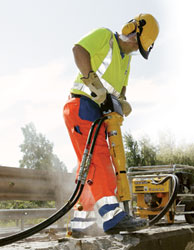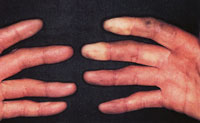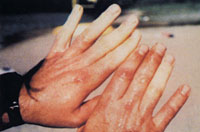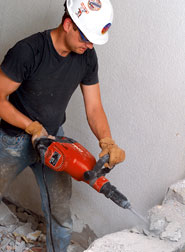 Atlas Copco Construction Tools LLC |
Just about every construction worker who spends most of the day breaking, grinding, drilling or sawing knows that it is not easy on the hands. The risk of long-term injury that results from hand-arm vibration is well known and has been heavily documented over the last century. Many scientists believe that hard work can be accomplished without the hand, arm and shoulder pain associated with power tools, and large employers looking to reduce risk and claims don’t mind paying a small premium to make workers more comfortable. That is why regulations across the Atlantic are limiting workers’ exposure to occupational vibration, forcing employers and suppliers to rethink and retool. Thanks to global manufacturing, though, you do not have to book a ticket to Brussels to start taking advantage of the good vibrations in power tools.
 Atlas Copco Construction Tools LLC Flexible handles dampen shock for big tools that bust up hard materials.
|
Vibration is a big problem in the construction industry. According to scientists at the Washington, D.C.-based National Institute for Occupational Safety and Health, about 540,000 construction workers a year are exposed to whole-body vibration from bouncing around in the cabs of heavy-duty machinery. All types of industries combined, including truckers, whole-body vibration potentially impacts the lives of about eight-million people. Sore backs are not the only casualties of occupational vibration, however.
Up to 3 million people in the U.S. are exposed every year to another kind of occupation hazard called hand-arm vibration, from using power tools like pavement breakers and hammer drills.
|
Construction represents about 1 million of those workers, and about 250,000 construction workers are exposed to the highest levels of hand-arm vibration, at least 5.0 meters per second-squared. Vibration experts have developed this threshold by taking into account vibratory distances in two directions, back and forth on three axes, for six movements total. Power tools that are the harshest on the hands include road breakers, demolition hammers, stone chisels and hammer drills (see chart, below).
Power tool manufacturers that sell in Europe, where vibration regulations are now in place, publish the data for employers to see. According to an online database of about 2,300 tools sponsored by the European Union and other research centers, about 30% of all power tools generate vibration levels higher than 5.0 m/s2. A link to this database is available online at www.enr.com.
For construction users, the risk of getting a serious injury, such as hand-arm vibration syndrome (HAVS), is as much as 50%, and it can take as soon as several months or as long as a few years to start showing symptoms. No one knows exactly how many people have HAVS in the U.S. because cases usually are classified as broader musculoskeletal disorders that encompass other occupational problems, such as carpal-tunnel syndrome, which HAVS also can help trigger.
Workers Get 'Sunk'
Also known as vibration-induced white finger, “dead hand” or secondary Raynaud’s disease, HAVS has no apparent cure. The symptoms start with a tingling sensation in the fingertips, followed by numbness. So called “white-finger” attacks last about 15 minutes and happen intermittently. They look and feel similar to frostbite and often are triggered by cold weather. After more exposure, they come on in all seasons. The tips of the fingers begin to permanently blanche, eventually creeping toward the knuckles. Painful attacks come on more frequently, and smoking can exacerbate these attacks, as nicotine works to constrict blood vessels. Still more exposure to vibration can lead to gangrene and amputation.
 |
 |
 |
 White-finger is permanent and gets worse with exposure. Symptoms can take months or years to develop.
(Photos Reprinted with permission. Source: Pelmear PL and Wasserman DE. Hand Arm Vibration: A comprehensive guide for occupational health professionals, second Edition. ©1998 by OEM Press. OEM Press, Beverly Farms, MA 01915. www.oempress.com. 978-921-7300) |
“The sickness, sadly, is irreversible,” says Donald E. Wasserman, a vibration consultant and former NIOSH scientist in Cincinnati, Ohio. “Once you get this disease, you’re kind of sunk, and you have to get another job.” Some workers use prescription drugs such as calcium-channel blockers to regulate blood circulation and relieve symptoms, but the disease still persists for life, doctors say.
Victims in the U.K. offer chilling accounts of how the problem feels as it progresses. “Gripping with my thumbs is very difficult and painful…I dread the cold winter months,” says one mechanic. A fabricator adds, “Sometimes, there’s a frost on the tools…that accentuates the feelings, and they’re dead, very dead, numb all the while.”
Research on HAVS began in 1918 in limestone quarries in Indiana. Ergonomics, beyond just vibration but also extending to tool weight, shape and angle of attack, became a hot issue in the 1990s, as claims became more prevalent and the U.S. and Europe furiously gathered data for new regulations. At that time, tool-makers began softening grips and lightening battery packs. Labor unions also were lobbying Washington for an ergonomics standard, which was proposed but never enacted.
Consumers and voluntary consensus standards have continued largely to direct toolmakers to improve vibration. But the E.U., which enacted a vibration directive in June 2002, spurred drastic changes that are having global effects on power-tool users. Since 2005, employers there have been required to monitor vibration, keeping workers at an average exposure level of no more than 5.0 m/s2 for every eight-hour work period. Wasserman likens that maximum limit to a red light at an intersection. At that point, employers must try to cut vibration in half or risk getting fined. Once workers hit 2.5 m/s2, it is like hitting a yellow light: Employers have to put safety and health programs in place to mitigate risk so vibration does not eventually hit the red light. The E.U. also enforces whole-body vibration levels.
 NIOSH NIOSH is studying hand-arm vibration using a new device that measures movement.
|
The U.S. has no vibration mandates beyond voluntary consensus standards. It nearly did, as the Occupational Health and Safety Administration had intended to include vibration-prevention measures in its now-defunct ergonomics regulation. OSHA officials confirm that the agency enforces vibration in its general-duty clause, however. NIOSH continues to study vibration and its effects on workers.
Designers Retool
Thanks to the E.U. standards, there is a new generation of tools designed to dampen vibration at the user end of the tool without decreasing breaking, drilling and grinding performance at the business end. And those models are starting to creep into the U.S. as the highly-competitive, $12-billion domestic power-tool industry continues its fierce drive for better power, performance and comfort.
“We’ve had a lot of new [low-vibration] products introduced over the last couple of years,” says David Schimmel, director of power tools for Tulsa, Okla.-based Hilti Inc. The Liechtenstein-owned company introduced its first low-vibration tool, a heavy concrete breaker, in 1998, but like most manufacturers, it has been broadening its line due to the E.U. directive. Tools with low vibration features now are moving into the U.S. and Asia as a result.
 Hilti Corp |
 Hilti Corp. |
lengthen their life. | |
Designers are putting dampening technology in three main areas on power tools: The handle, fitted with springs or rubber gaskets, is getting more flexible. The drivetrain also is better able to absorb shock using springs, steel counterweights and a heavier casing. Special gearing and tuning also is speeding up the frequency of a tool’s pounding, drilling and chipping, while the amplitude of each hit is going down.
The effect is a breaker, for example, that rams against concrete faster but doesn’t pound as hard, and does the work in the same amount time as its predecessor. “There are several ways you can beat the drill bit against the concrete,” explains Schimmel. “You can hit it hard, or you can hit it a lot more times with lower...
 Related Links:
Related Links: 

Post a comment to this article
Report Abusive Comment